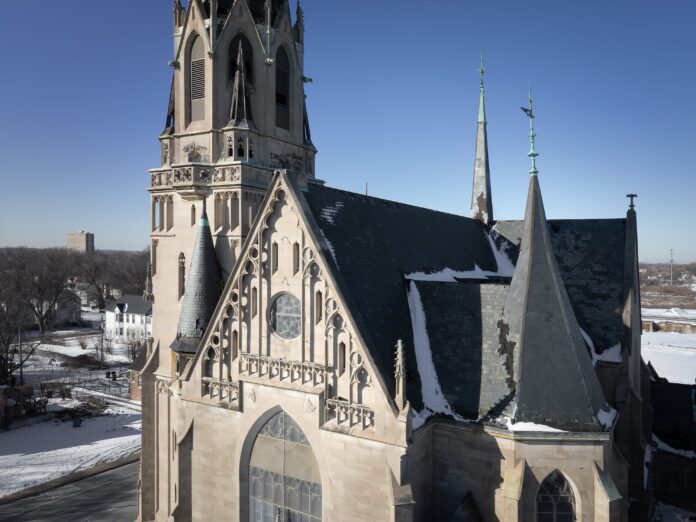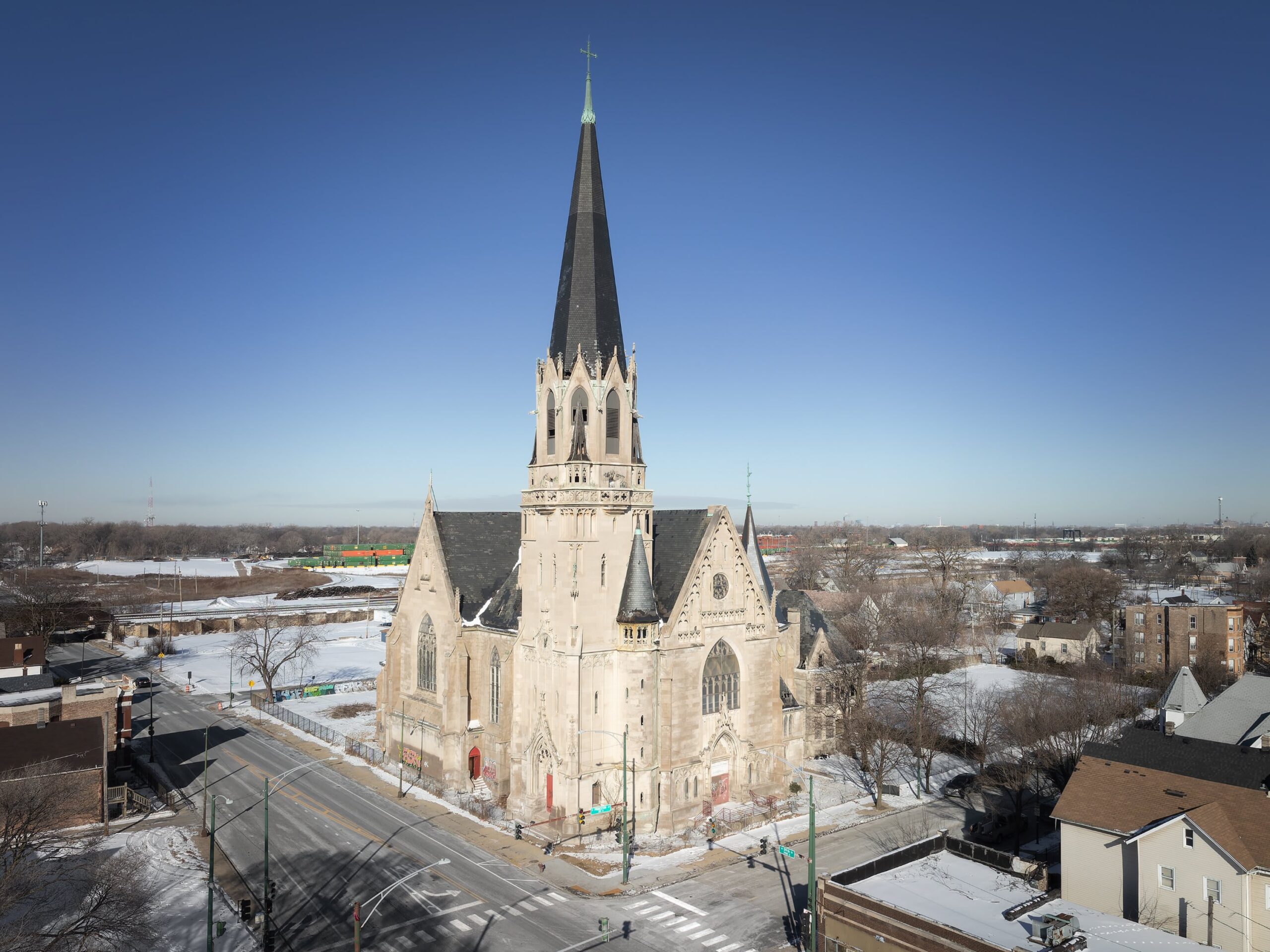
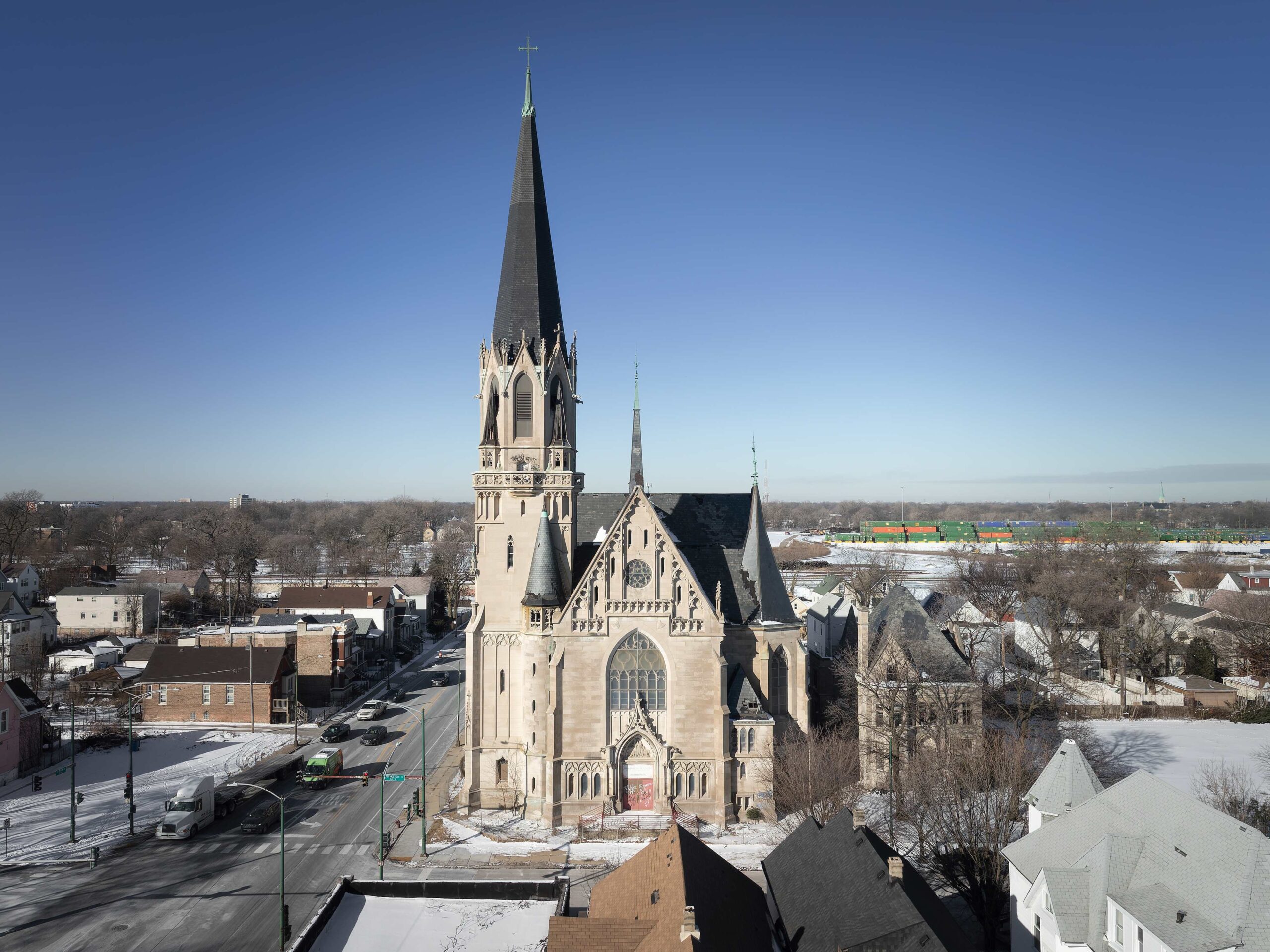
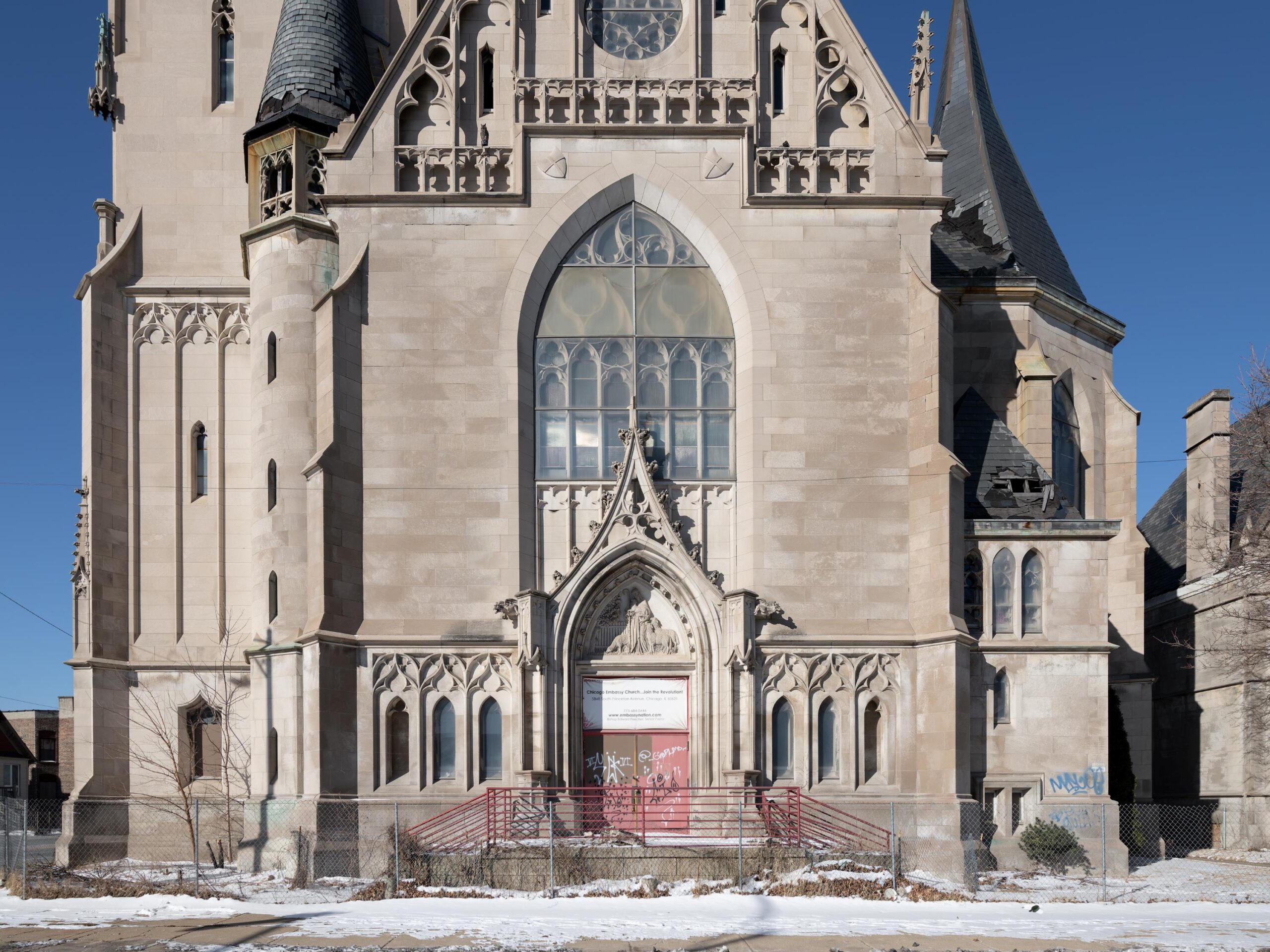
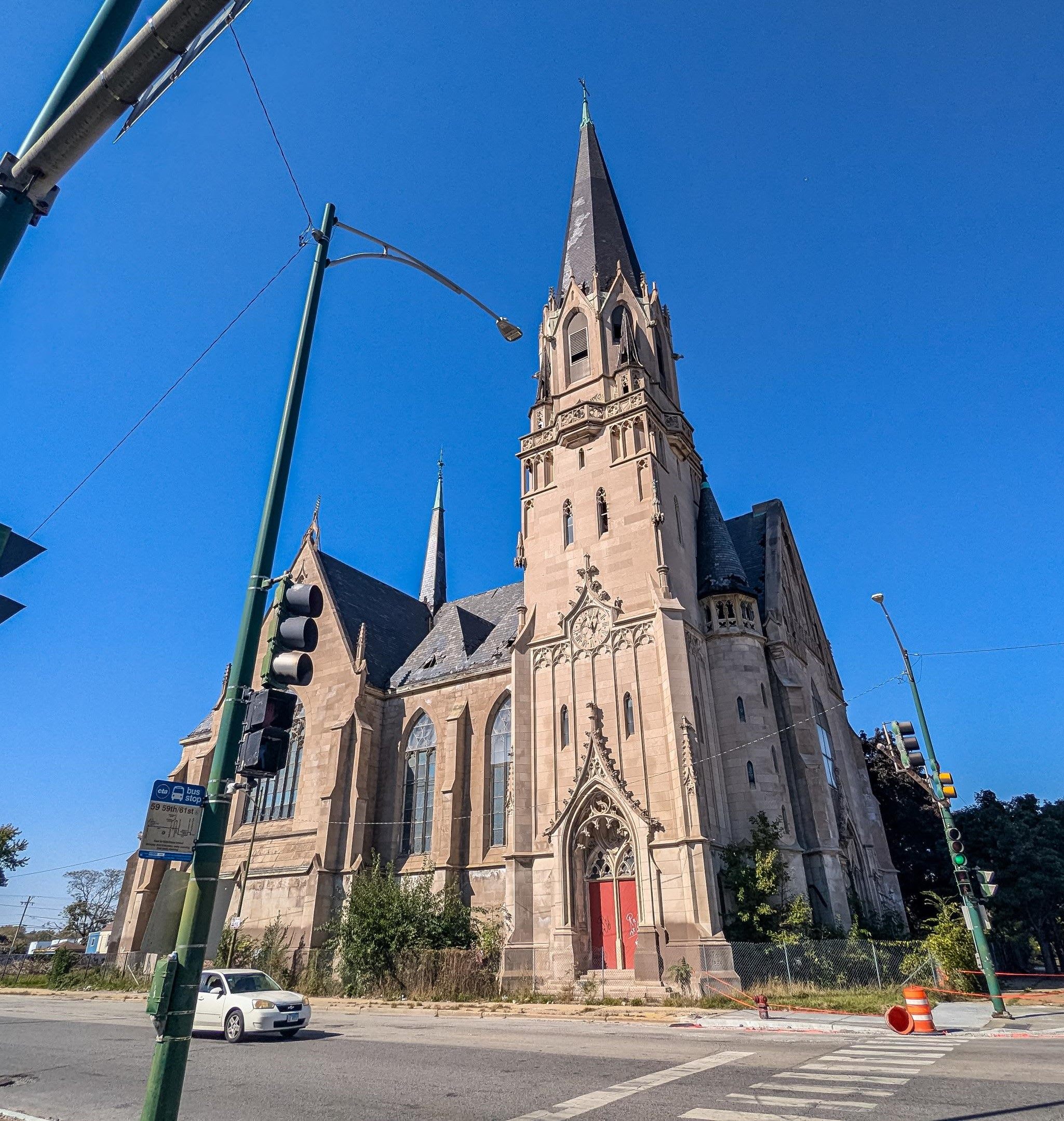
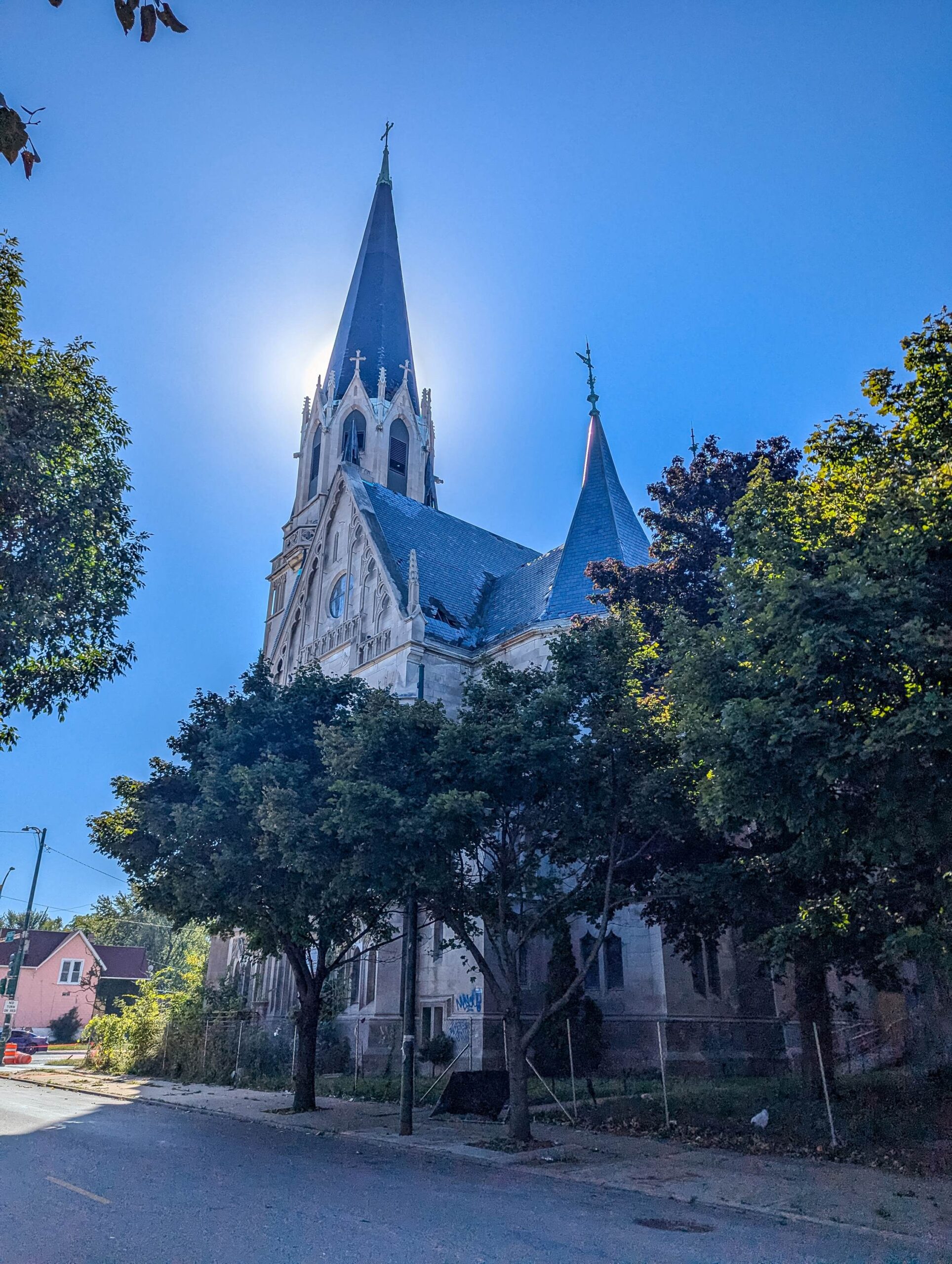
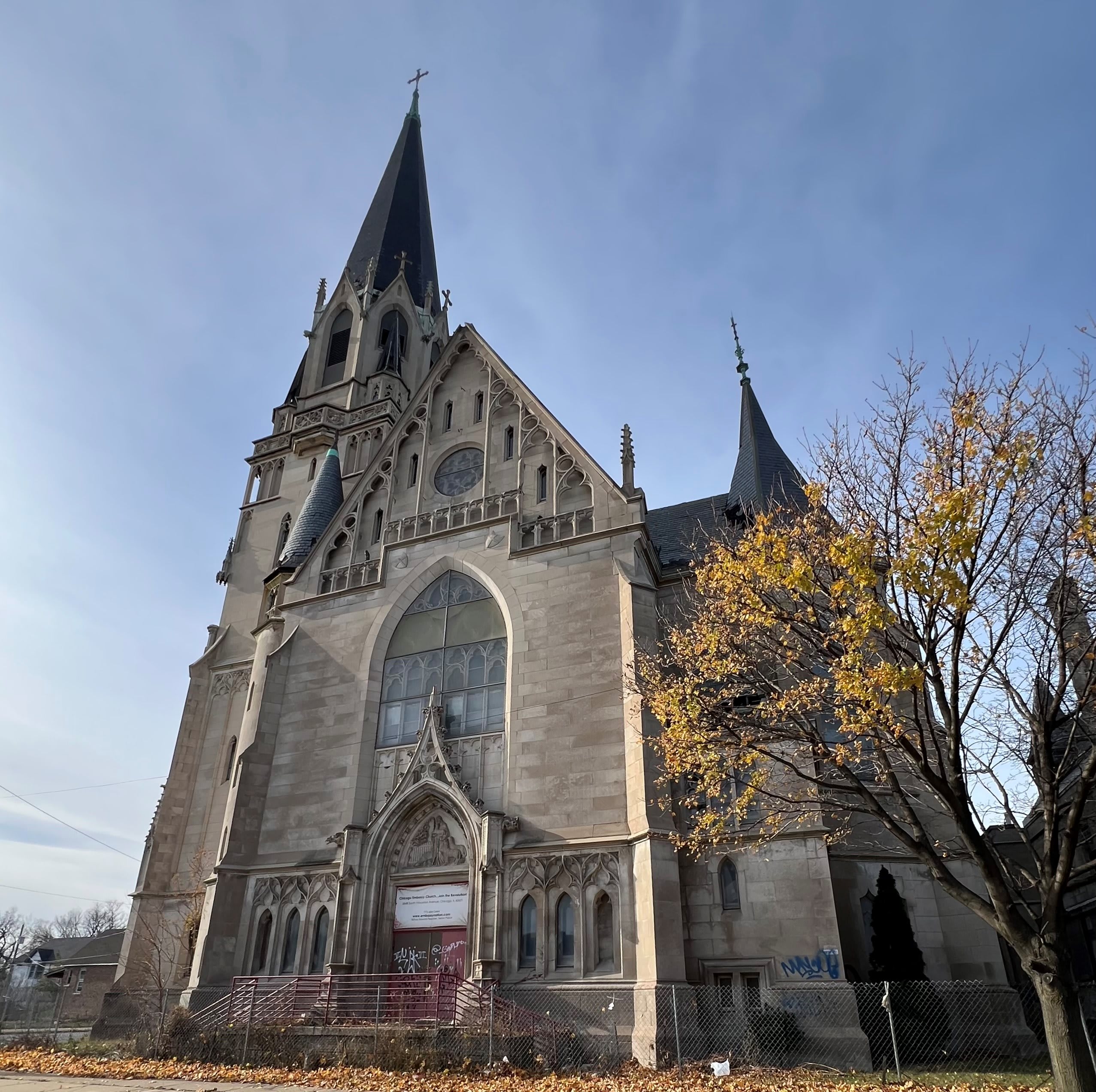
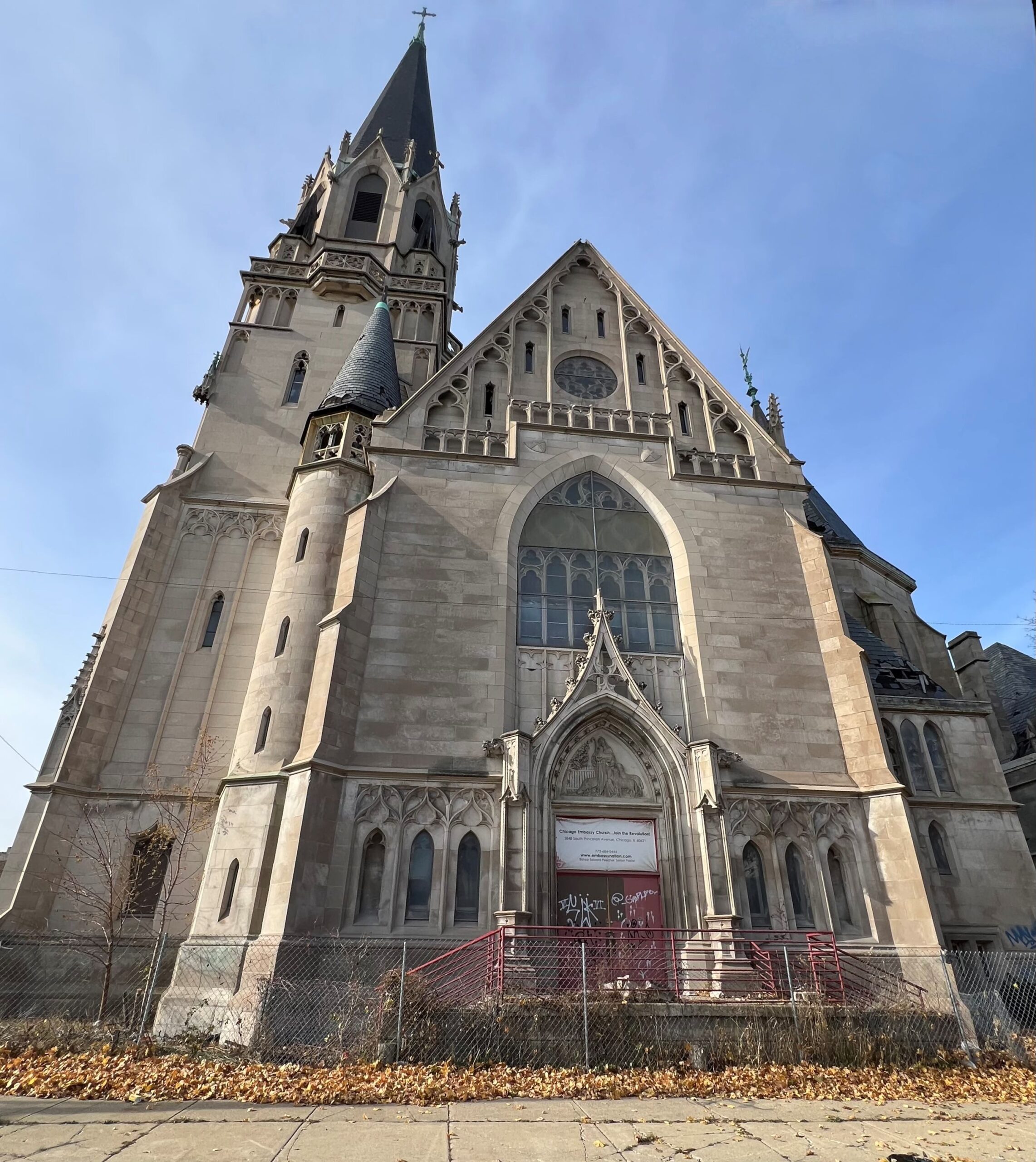
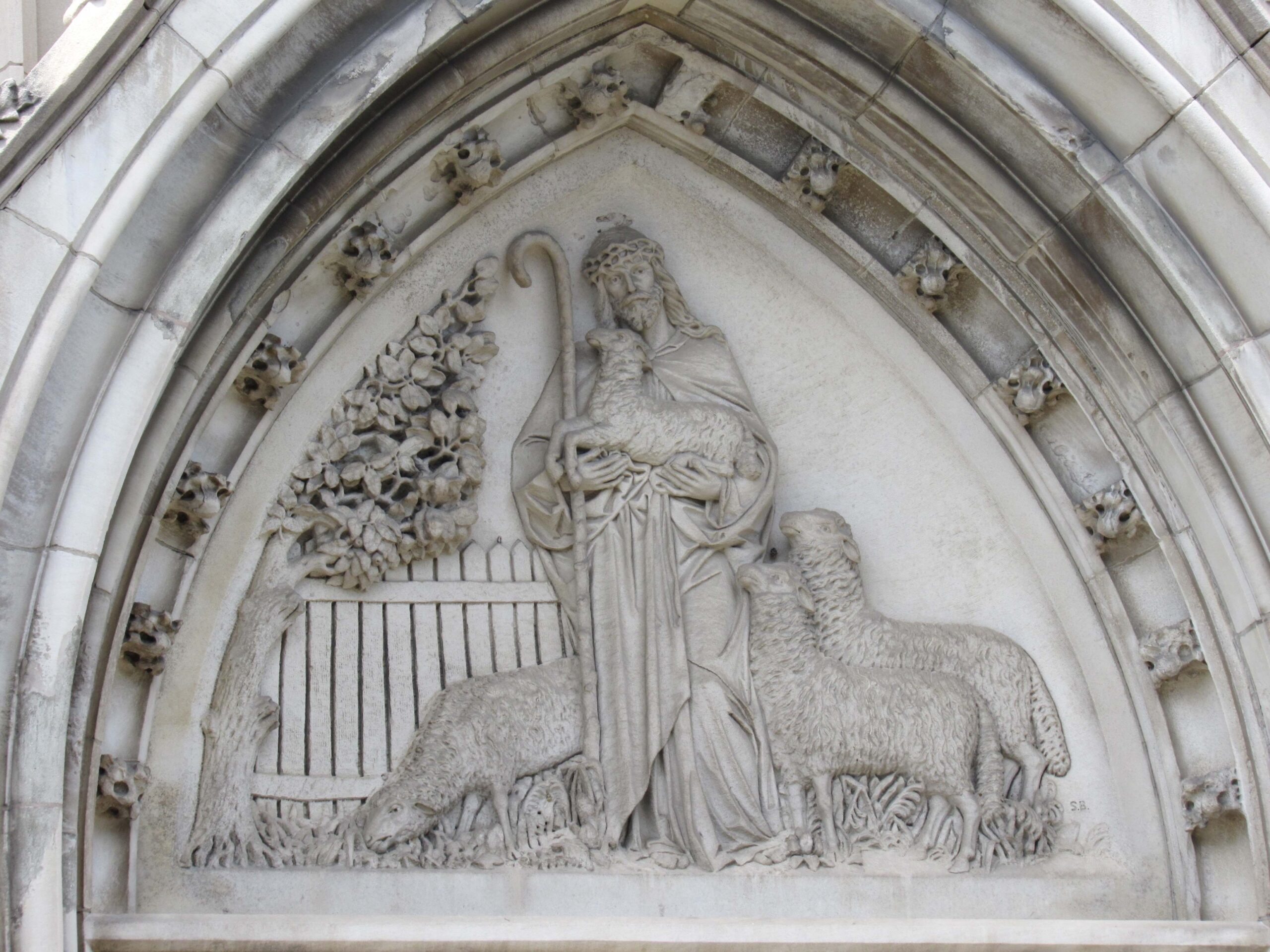
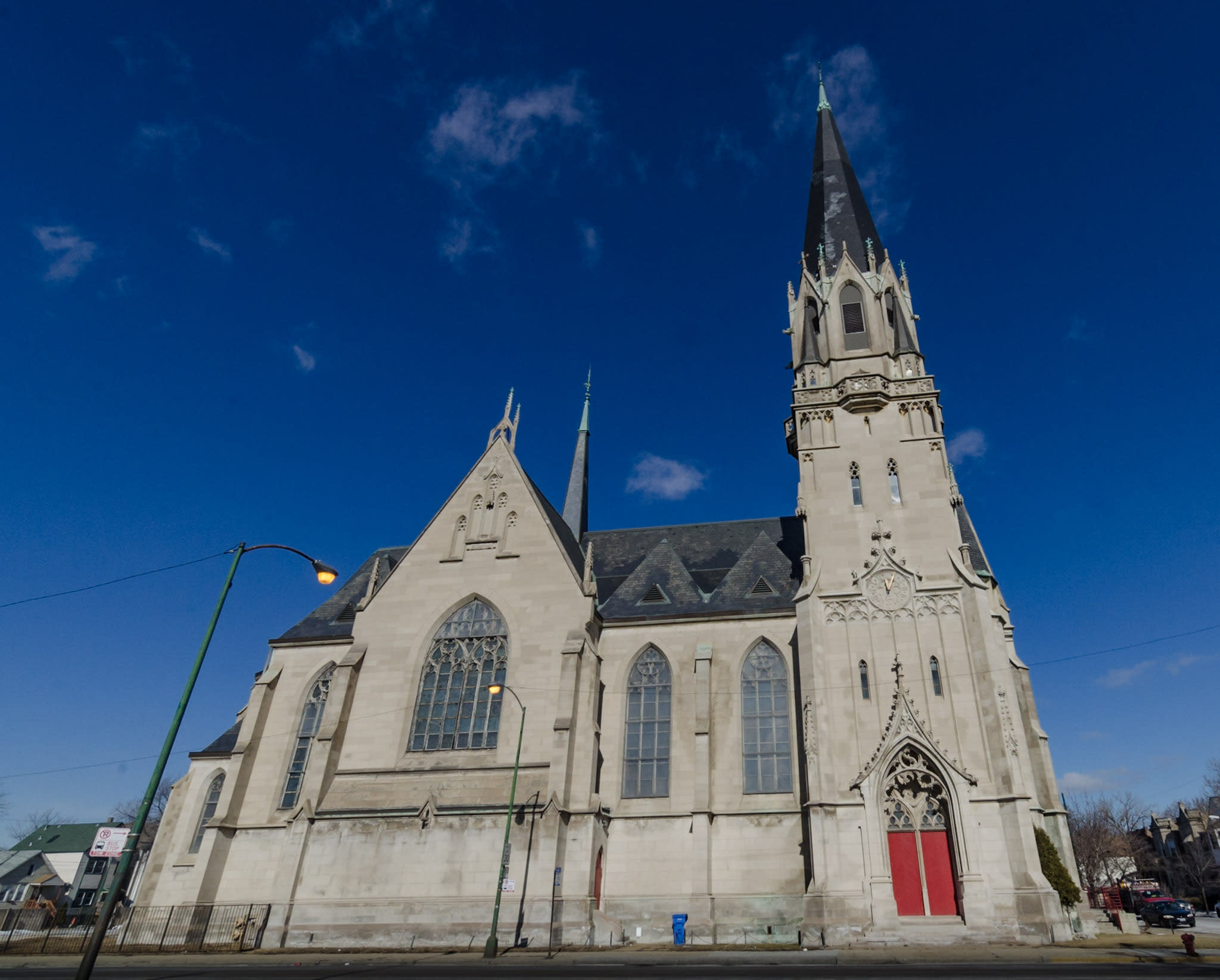


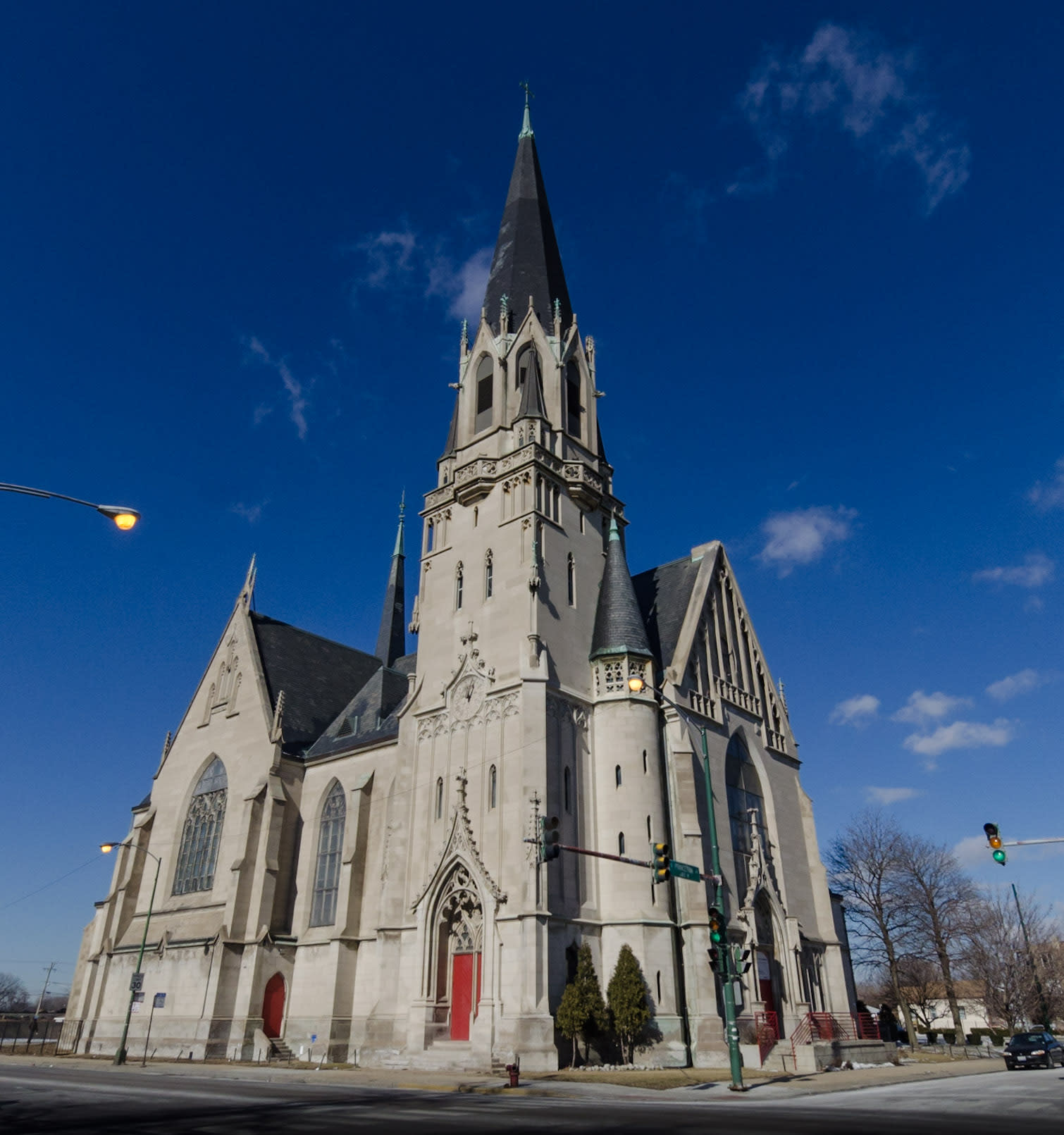
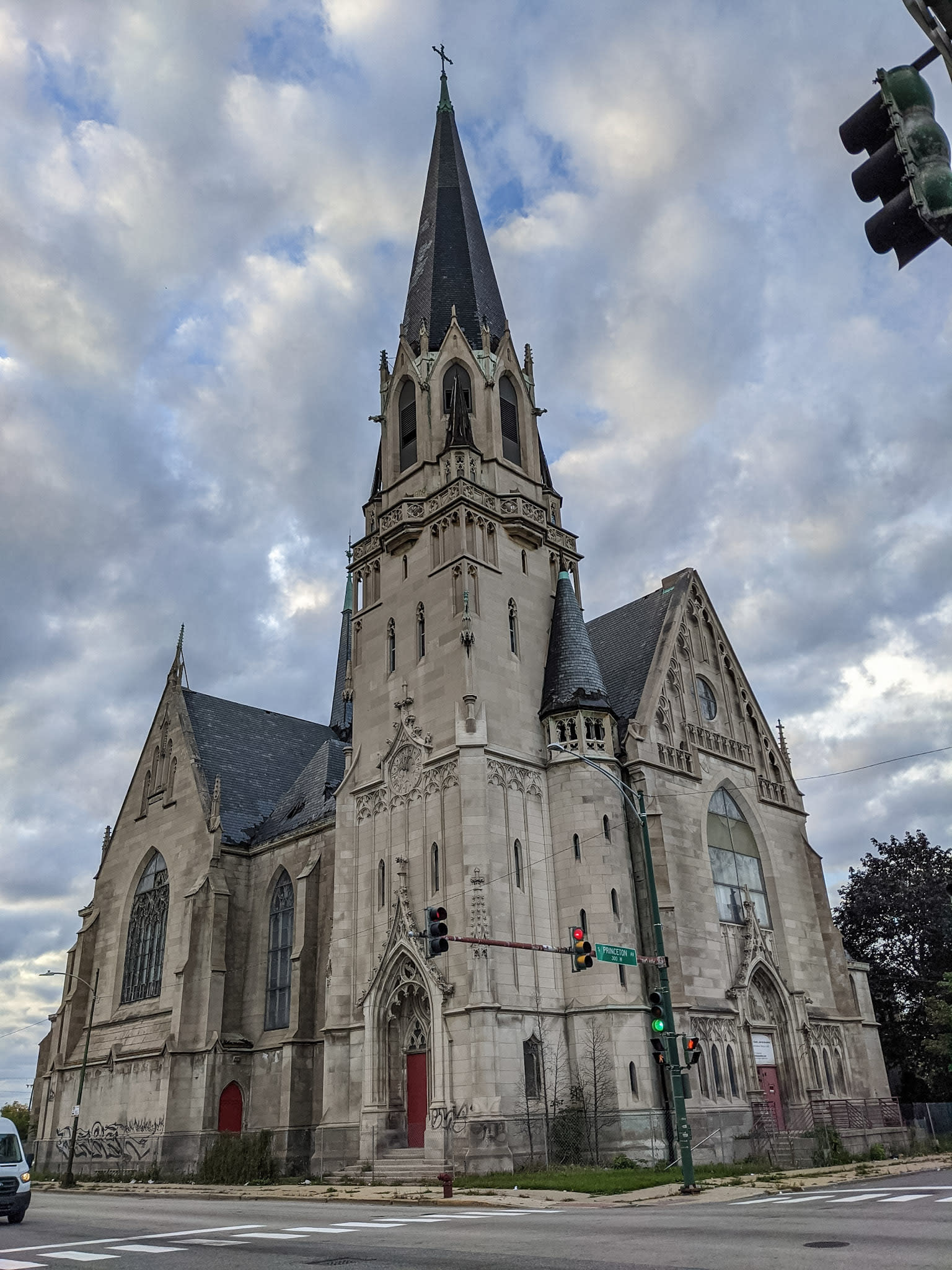
St. Martin’s Church
formerly St. Martin de Tours Church, and later renamed St. Martin de Porres Church; and Chicago Embassy Church
Address: 5848 S. Princeton Avenue
Architect: Henry J. Schlacks; Louis Becker
Date: 1895
Style: Gothic Revival
Neighborhood: Englewood
Overview
Historic churches are some of both the oldest and finest examples of architecture throughout Chicago’s neighborhoods. They are part of the fabric of the city, beloved landmarks, and provide a direct connection to a neighborhood’s past. The prominent ecclesiastical building that stands on the corner of Princeton Avenue and 59th St. in Englewood, originally constructed as St. Martin de Tours Church, is an outstanding example of the city’s architectural heritage. St. Martin’s is reflective of a time when Chicago was famous for having houses of worship on nearly every block, one for nearly every ethnic group and immigrant community.
St. Martin de Tours was built in 1895 for Chicago’s growing German Roman Catholic community in the Englewood Community of Chicago’s South Side. The plans for the building were drawn up by Louis Becker of Mainz, Germany, and completed by accomplished Chicago architect Henry J. Schlacks. Per an 1894 article published in Chicago’s Inter Ocean Newspaper in 1894, St. Martin’s design was a “conscientious endeavor to put forth for the first time in Chicago, if not the country, an edifice of pure style in Gothic church architecture.” The church is a historical artifact from the Gothic Revival movement in the United States and remains one of the finest examples of German and French Gothic architecture in the country.
St. Martin further stands as a testament to Englewood’s demographic shift, and to a long tradition of church buildings being repurposed for a diverse set of congregations. The church under the ownership of the Catholic Archdiocese of Chicago, was later renamed to St. Martin de Porres to honor the neighborhood’s large African American population, before its eventual closure in 1989 due to dwindling attendance. The building was sold and reopened in 1998 as the Evangelical Chicago Embassy Church, also known simply as “The Chicago Embassy Church,” serving an Evangelical Black congregation, in addition to former Catholic members of St. Martin’s.
St. Martin’s has been shuttered since 2017. In addition to years of deferred maintenance, the church building has suffered considerable deterioration due to vacancy and neglect. St. Martin was previously listed as a Chicago 7 Most Endangered in 2022, but unfortunately conditions have remained largely unchanged. Preservation Chicago again recommends the restoration of this magnificent and storied church, along with its adjoining former rectory strcuture, and the creative reuse of the buildings would aid in a spiritual and social renewal of this corner of Englewood.
History
St. Martin was built for the German Catholic community in the then suburban town of Englewood in 1886. The German-speaking population of Chicago grew tremendously after 1872, and St. Martin was the third German church built in the Englewood area (both earlier churches are now demolished). The church was built up from its humble beginnings through the enthusiasm of its first reverend Rev. John Schaefer, and the support of his parishioners. A year after St. Martin de Tours was erected, it was called “the pride of the German residents of that part of the city,” and its members continued raising funds to furnish the building with four new bells, statues, and a grand organ. The crown jewel of the church was an 1895 statue of St. Martin the Beggar, carved by Sebastian Buscher out of poplar and weighing 1,600 pounds. The statue was prominently placed atop the building’s 228-foot-tall steeple. It was one of the first colossal wooden statues completed in the United States and represented a 4th century Roman soldier who cut his cloak in half to share with a beggar on a cold night.
Reverend Francis J. Schikowski, an immigrant born in Germany, became the leader of the church in 1890 and served there until his death in 1941. Over the course of his tenure and with the continual growth of the German immigrant population, St. Martin expanded its campus and services to care for the poor and the needy. In addition to the Becker and Schlacks-designed main Gothic church, a 3-story school was designed by Hermann J. Gaul, another noted ecclesial architect of German descent, at 5830-38 S. Princeton. There were 30 priests and several thousand attendees at the 1909 dedication of the new school and parish building. A two-year high school was later added and enrollment as well as the number of parishioners continued to increase. In the 1920s and 30s the congregation continued to purchase property and make improvements to the building. In 1935, the original statue of St. Martin the Beggar mounted atop the highest gable of the church, was replaced by a new one, made of lead coated copper, and again depicting the figure on a horse, designed by Gaul. This new statue indicated the congregation’s growing prosperity and was even covered in gold leaf in 1949 and restored again in 1960. This gold statue was severely damaged and displaced from its prominent high gable fronting Princeton Avenue and the Dan Ryan I-90-I-94 Expressway in a storm and removed for repairs, and later lost.
At the time of Reverend Schikowski’s death, the congregation was no longer “thoroughly German,” and English had replaced the German language in sermons, announcements, and publications. The postwar era saw an increasingly multiethnic community. German attendees were joined by Irish, Italian, Lithuanian, Mexican and African American families. At the same time enrollment at St. Martin’s Catholic School began to fall and non-Catholic students were newly admitted. In the 1950s the number of African American congregants increased and attendance across church and school increased to its previous 1920s height.
The 1961 construction of the Dan Ryan Expressway displaced many Englewood residents and St. Martin congregants. Although attendance dwindled, the church continued to offer a food pantry, senior lunch program, and scouting, among other services until its closure by the archdiocese in 1989. The parish was renamed in the decade before its closing for St. Martin de Porres, a Black Dominican from Lima, Peru, who comforted the sick and provided for the poor. Even as the church experienced decline, the statue of St. Martin, perched on its high stone gable, continued to serve as a landmark for pilots approaching Midway Airport, and as a marker for commuters on the Dan Ryan Expressway.
After its closure, the building stood vacant for almost a decade. When the Chicago Embassy Church, an Evangelical Black congregation, purchased the building in 1998, and the building was described as “some sorry stuff.” The congregation’s original leader, Bishop Edward Peecher, and volunteers found it with no electricity or heat, a floor needing reinforcing, pieces of the ceiling and insulation falling in pieces to the floor and reportedly piles of garbage in place of pews. Chicago Embassy Church took out loans to make necessary repairs, drew 300 attendees from across the city, including former members of St. Martin’s Catholic Church and School, and eventually began a summer day camp and afterschool program.
In 2006, the massive and iconic statue of St. Martin was blown off the steeple in a windstorm. It was never repaired, or replaced, but as Assistant Bishop Nance of Embassy Church was quoted, “the statue can tell the story of the Englewood community and where it was, and where it is. And our job is to declare where it is going.” Although Chicago Embassy Church stopped operating out of the church building at the corner of Princeton Ave and 59th St. in 2017, and the building has since remained vacant, Preservation Chicago believes that the church can again guide the future of Englewood. With a restoration of the church to its former glory, and the replacement of its moving and prominent statue, St. Martin can again serve as a visual landmark of hope and community on the Southside. If a house of worship is determined not feasible, the former church building could serve as a community center, offering humanitarian services, community outreach and be both a health and wellness center, in addition to a food pantry.
Architectural Contributions
In addition to its role in the history of Englewood’s German and African American community, St. Martin’s magnificent architecture contributes to Chicago’s rich architectural heritage and the canon of Gothic Revival throughout the United States. In 1894, the church was lauded for its purity of gothic detail, including its large gothic windows with intricate tracery, and crockets decorating a steep gable above its grand main entrances. The church includes foliated ornamentation on its main façade, double interlacing tracery above its doorways, blind tracery at the basin of its massive corner tower, and narrow arched windows throughout. The church’s integrity to the Gothic form may well derive from its original plans devised by the architect Louis Becker, who sent his drawings to Chicago from Mainz, Germany. The building was realized by Henry J. Schlacks and is considered his most impressive built work.
The structure’s most striking feature is its soaring 228-foot-tall stone steeple atop a massive tower, inset with projecting balconies, pinnacles, and even attached to a turret. The entire building has strong massing and has a distinct presence from each angle. The façade is clad in well-kept buff Bedford limestone from Indiana, and its exterior detail is well preserved. Unfortunately, much of the stunning interior wooden carved details have been lost, but the beautiful stained-glass windows that line the church’s nave and which were designed and manufactured in Munich and Innsbruck studios are still extant. The 72-register, 3,000-pipe organ built by Johnson and Son, purchased with funds hard earned by St. Martin’s original congregants, was once played at Chicago’s Central Music Hall, the city’s original Orchestra Hall, and was donated to St. Martin by Mrs. Marshall Field, Jr. The current interior of St. Martin is now quite spare and features mostly plaster and brick in poor condition.
Threat
St Martin, despite its deterioration, continues to dominate the built landscape of Englewood’s two-story frame homes. It has acted as a backdrop for the lives of Englewood residents for over 121 years. Unfortunately, it is in quite a compromised condition. Some of its windows have been damaged, its façade graffitied, and sections of the roof are damaged. Preservation Chicago is worried that the interior is or will become exposed to the elements, leading to the further decay of the structure. Without intervention, this grand structure will continue to steadily decline. Its lack of heat, inclement weather, and deferred and crucial maintenance will all lead to worsening states of decay. The church requires creative reuse and occupancy to rehabilitate the structure.
Recommendations
Despite its condition, St. Martin could surely house a new congregation and continue operation as a place of worship. Assuming lack of interest or demand for continued religious use, the building is nonetheless suited for adaptive reuse. There are numerous examples across Chicago and the United States of the successful conversion of former churches and synagogues to new desired uses, whether residential, commercial, recreational, in addition to health and wellness and community centers. The structure is orange-rated within the Chicago Historic Resource Survey, thus triggering 90-Day Demolition Delay, but also easily meets the standards for local landmark designation. Formal designation in tandem with public subsidies would ease the path to eventual rehabilitation, and ensure that this visual and spiritual landmark of Englewood remains standing and is returned to productive use.


